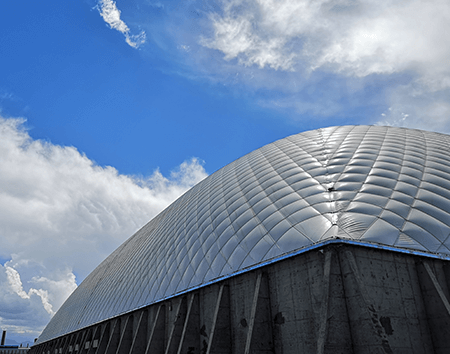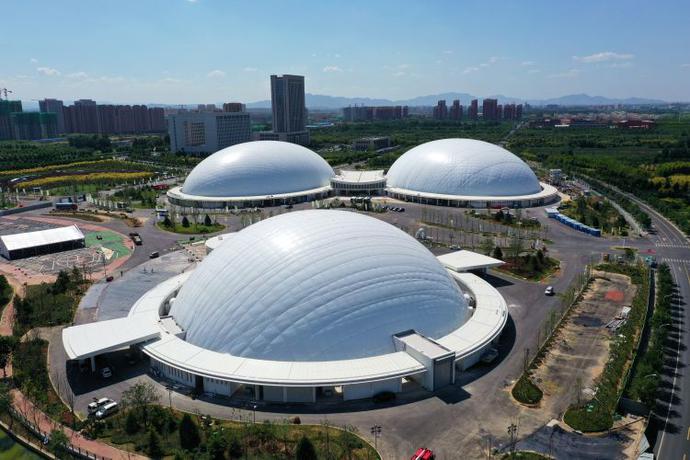News
Site Editor
 Site
/uploads/image/677267645dfcf.png
As businesses face increasing pressure to reduce costs, improve efficiency, and operate sustainably, air domes offer a viable solution for many commercial projects. Their cost-efficiency, rapid deployment
Site
/uploads/image/677267645dfcf.png
As businesses face increasing pressure to reduce costs, improve efficiency, and operate sustainably, air domes offer a viable solution for many commercial projects. Their cost-efficiency, rapid deployment
The Economic Benefits of Air Domes in Commercial Projects
Views: 2032
Author: Site Editor
Publish Time: 2024-08-15
Origin: Site
In recent years, air-supported structures, commonly known as air domes, have gained significant popularity in various sectors. These versatile and cost-effective structures are being utilized in sports facilities, storage solutions, agricultural applications, and even large-scale commercial projects. As the demand for flexible, scalable, and energy-efficient solutions increases, air domes present a compelling option for businesses looking to optimize their operations. This article explores the economic benefits of air domes in commercial projects, highlighting their cost-efficiency, rapid deployment, and environmental advantages.
Cost-Efficiency
One of the most significant advantages of air domes is their cost-efficiency compared to traditional building structures. The initial investment required for an air dome is often significantly lower than that of conventional brick-and-mortar buildings. This cost difference arises from several factors:
-
Material Costs: Air domes are primarily constructed from specialized fabric materials that are lightweight yet durable. These materials are less expensive than the concrete, steel, and glass commonly used in permanent buildings. Additionally, the foundation requirements for air domes are minimal, further reducing material costs.
-
Labor Costs: The construction of air domes requires less labor than traditional buildings. The simplicity of the design and the use of prefabricated components allow for a faster and more streamlined construction process. This reduction in labor translates to lower overall costs for businesses.
-
Maintenance Costs: Air domes are designed to be low-maintenance structures. The materials used are resistant to harsh weather conditions, UV radiation, and other environmental factors, reducing the need for frequent repairs or upkeep. Additionally, the modular nature of air domes allows for easy replacement of damaged sections without significant disruption to operations.
Rapid Deployment
Time is money in the business world, and the ability to quickly establish functional facilities can be a game-changer for many commercial projects. Air domes excel in this area due to their rapid deployment capabilities:
-
Quick Installation: Unlike traditional buildings, which can take months or even years to complete, air domes can be erected in a matter of weeks. This speed is particularly beneficial for businesses that need to expand operations quickly or establish temporary facilities for specific projects or events.
-
Scalability: Air domes offer unparalleled scalability, allowing businesses to easily expand or reduce the size of their structures as needed. This flexibility is ideal for companies that experience fluctuating demand or need to adapt to changing market conditions. For example, a company can start with a smaller dome and expand it as their business grows, all without the need for extensive renovations or new construction.
-
Mobility: In addition to their rapid deployment, air domes are also highly portable. This mobility allows businesses to relocate their facilities as needed, whether to take advantage of new opportunities, respond to changing market conditions, or optimize their operations. For example, a company can use an air dome as a temporary storage solution during peak seasons and then move it to another location when demand decreases.

Environmental Advantages
Sustainability is becoming an increasingly important consideration for businesses worldwide. Air domes offer several environmental benefits that can contribute to a company's sustainability goals while also reducing operational costs:
-
Energy Efficiency: Air domes are inherently energy-efficient due to their design. The air-supported structure creates a natural insulation layer, reducing the need for heating and cooling. This efficiency is further enhanced by the use of advanced materials that reflect sunlight and reduce heat absorption. As a result, businesses can achieve significant energy savings, particularly in climates with extreme temperatures.
-
Reduced Carbon Footprint: The construction and operation of air domes result in a lower carbon footprint compared to traditional buildings. The reduced need for construction materials, lower energy consumption, and minimal land disruption all contribute to a more sustainable building solution. This is particularly important for businesses that prioritize environmental responsibility or are subject to stringent regulatory requirements.
-
Minimized Waste: The modular nature of air domes allows for easy disassembly and relocation, reducing the amount of waste generated during construction and deconstruction. Additionally, the materials used in air domes are often recyclable, further minimizing environmental impact.
Versatility and Adaptability
Air domes are not just cost-effective, rapid to deploy, and environmentally friendly; they are also incredibly versatile. This adaptability makes them suitable for a wide range of commercial applications, from warehouses and logistics centers to sports facilities and exhibition spaces:
-
Customizable Design: Air domes can be customized to meet the specific needs of a business. This includes the ability to incorporate various features such as HVAC systems, lighting, and interior partitions. The flexible design allows companies to create a tailored environment that meets their operational requirements without compromising on quality or efficiency.
-
All-Weather Performance: Air domes are designed to withstand various weather conditions, from heavy snow loads to high winds. This all-weather performance ensures that businesses can continue operations without interruption, regardless of external factors. For companies operating in regions with harsh climates, this reliability is a significant advantage.
-
Multi-Use Spaces: The open-plan design of air domes provides businesses with a multi-use space that can be easily reconfigured for different purposes. Whether used as a storage facility, a production site, or a venue for events, air domes offer the flexibility to adapt to changing needs. This versatility can be particularly valuable for businesses that need to maximize the use of their space to remain competitive.
As businesses face increasing pressure to reduce costs, improve efficiency, and operate sustainably, air domes offer a viable solution for many commercial projects. Their cost-efficiency, rapid deployment, environmental benefits, and versatility make them an attractive option for companies looking to optimize their operations. Whether used as a temporary facility or a long-term solution, air domes provide a flexible and scalable option that can help businesses achieve their goals while minimizing their environmental impact. As the demand for innovative building solutions continues to grow, air domes are poised to play a significant role in the future of commercial construction.









